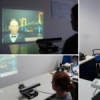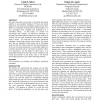ICIA
2007
14 years 2 months ago
2007
In a conversational system, determining a user’s focus of attention is crucial to the success of the system. Motivated by previous psycholinguistic findings, we are currently e...
FGR
2004
IEEE
14 years 3 months ago
2004
IEEE
Eye gaze estimation is to detect the eye gaze of human. By detection of the eye gaze, a machine can read the intention. Eye gaze is very useful to read human intention. In this pa...
Publication
We investigate the usability of an eye controlled writing interface that matches the nature of human eye gaze, which always moves and is not immediately able to trigger the selecti...
Publication
While objects of our focus of attention (“where we are looking at”) and accompanying affective responses to those objects is part of our daily experience, little research exis...
IVA
2009
Springer
14 years 4 months ago
2009
Springer
In human-human conversation, the
first impression decides whether two people feel attracted by each other and whether contact between them will be continued or not. Starting from ...
SIBGRAPI
1999
IEEE
14 years 4 months ago
1999
IEEE
Advanced Human Computer Interaction (HCI) techniques are required to enhance current computer interfaces. In this paper we present an eye gaze tracking system based on a robust low...
CHI
1999
ACM
14 years 4 months ago
1999
ACM
This work explores a new direction in utilizing eye gaze for computer input. Gaze tracking has long been considered as an alternative or potentially superior pointing method for c...
CHI
2000
ACM
14 years 4 months ago
2000
ACM
Eye gaze interaction can provide a convenient and natural addition to user-computer dialogues. We have previously reported on our interaction techniques using eye gaze [10]. While...
WACV
2002
IEEE
14 years 5 months ago
2002
IEEE
We present a method for estimating eye gaze direction, which represents a departure from conventional eye gaze estimation methods, the majority of which are based on tracking spec...
ICCV
2003
IEEE
14 years 5 months ago
2003
IEEE
In this paper, we present a novel approach, called the “one-circle” algorithm, for measuring the eye gaze using a monocular image that zooms in on only one eye of a person. Ob...




